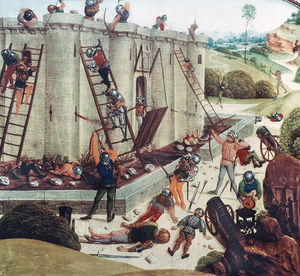Siege of Kraken's Watch
|
The Siege of Kraken's Watch was a four month long siege during the Riga War of the Courlander keep of Kraken's Watch by the Carnatian League, commanded by Ser Rickard Barrow and Duke John of Carnatia. The Courlander forces were commanded by Duke Alexander of Courland, with the White Cross presence commanded by Ser Ulric von Aesterwald. Kraken's Watch, the goal for the Carnatian League, was all that stood between the League and a victory in the internal conflict. A victorious siege could end the war, and restore Kraken's Watch to the House of Vanir.
Prelude
The League's victory at the Battle of the Curon Forest had paved the way for a siege of Kraken's Watch itself. Ser Barrow had initially planned to surround the keep and starve out the defenders, but Kraken's Watch had more than enough food to outlast the besiegers. This forced Barrow to plan for a direct assault of the keep. Given the losses of the previous year, Courland had found itself lacking in funds, mostly due to outstanding debts to the mercenary order of the White Cross. This lack of money left Courland with but a few siege engines to defend the keep. The League, on the other hand, had the financial resources of three vassals, and was able to buy and construct multiple siege engines, nearly ten times as many as Courland. On the morning of the 14th of Malin's Welcome, Barrow ordered the bombardment of Kraken's Watch to begin.
Battle
The castle had not been built to act as a defensive fortification, and had been used by House Vanir as a residential holding during their reign as Dukes of Vanaheim. Barrow used this to his advantage, setting his catapults up on the hills behind the castle. The lack of defensive positions meant that a majority of the defenders were forced to take positions on the walls of the castle, where they were susceptible to archer and artillery fire. Barrow ordered his catapults to focus entirely on crumbling the walls, while the Lord Paramount had his skirmisher troop fire on the Courlander infantry.
The tactic worked, with multiple large sections of the wall crumbling under bombardment from League catapults, resulting in scores of Courlander soldiers crushed by the rubble. Staunton was forced to move his forces into the residential area of the keep, which provided slightly more cover than the exposed walls. In response, Barrow continued with his bombardment of the keep, causing massive casualties for the Courlanders. A continued bombardment was enough to cause many regiments of Courlander infantry to rout, leaving only a handful of infantry left to defend the keep. After realizing this, the Lord Paramount took the League's infantry, storming the keep and clearing it through from room to room. The League suffered very few casualties during the assault, while the Courlander survivors were able to withdraw back to the city of Riga to recuperate from the losses of the day.
Aftermath
The League's victory at the siege had resulted in the successful restoration of the House of Vanir to their noble status. Given the League's two successful victories during the war, they were eager to begin peace talks. Courland's defeats also helped foster anti-Imperial sentiments within the Duchy, as many residents saw the entire war as an effort by Emperor John II to destroy the Duchy. Duke Alexander had received an arrow wound during the fight, incapacitating him for some time. In his stead, his kinsman George Staunton took up leadership of Courland's war effort.
